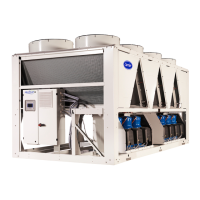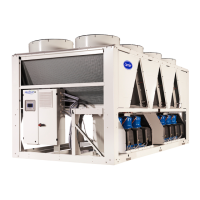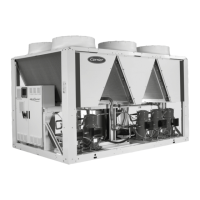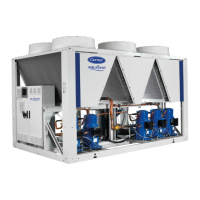41
• Compressors
Ensure that each compressor is rotating in the correct
direction, checking that the discharge temperature rises
quickly, the HP increases and the LP drops. If it is rotating in
the wrong direction, the electric power supply is incorrectly
wired (reversed phases). To ensure rotation in the correct
direction, swap the two power supply phases.
- Check the compressor discharge temperature with a contact
sensor
- Check the input current; it should be normal
- Check all safety devices to make sure they operate correctly
• Hydraulics
The exact total drop in system pressure will not be known at
commissioning. It will therefore be necessary to adjust the
ow of water with the control valve until the desired nominal
rate is obtained.
By causing the pressure in the water system to drop, this
control valve aligns the system pressure/ow curve with that
of the pump so that the nominal ow rate corresponding to
the desired operating point is obtained. The pressure drop in
the water exchanger (read using the pressure gauge placed on
the exchanger inlet and outlet) is the reference to be used to
check and adjust the nominal ow rate of the system.
Follow the procedure described below:
- Open the control valve completely
- Let the pump run for two hours to ush out any solid
particles in the circuit
- Read the pressure drop in the water exchanger when the
pump is turned on and then two hours afterwards
- If the pressure drop has decreased, this means that the screen
lter is clogged. It must be removed and cleaned
- Repeat until the lter is completely clean
- If the system pressure drops far below the available static
pressure delivered by the pump, the resulting water ow rate
will be reduced and the difference in temperature between
the exchanger inlet and outlet will be too high. This is why
pressure drops must be minimised. Make sure this difference
is within the values on the curve (refer to the chapter "Water
exchanger water ow")
• Refrigerant charge
Each unit is shipped with an exact charge of refrigerant.
The units use hermetically sealed scroll compressors.
Each compressor is equipped with a crankcase oil heater, as
standard.
There is no heater fault detection.
Each compressor sub-assembly has:
• Anti-vibration mountings between the unit chassis and
the chassis of the compressor sub-assembly,
• A safety pressure switch on the discharge line of each
circuit,
• Restrictors (not visible) on the suction pipes (for 3 and 4
compressor modules) to ensure oil level equalisation
between all compressors,
• Pressure and temperature sensors at the common suction
line and a pressure sensor at the common discharge line.
The compressors installed on the units have an oil charge,
ensuring good lubrication under all operating conditions.
The oil level check can be done:
• On the system: the oil levels must be greater than or equal
to half of the sight glass.
• A few minutes after the sub-function has come to a
complete stop: the oil levels must be visible in the sight
glasses.
If this is not the case, there might be a leak or an oil trap in
the circuit.
If there is an oil leak, find and repair it, then refill with
refrigerant and oil.
See the Service Guide for the oil removal and rell procedures.
Damage caused by frost is not covered by the warranty.
NOTE:
Only use oils which have been approved for the compressors.
Never use oils which have been exposed to air.
Polyolester oils are completely incompatible with
mineral oils.
Only use the oils specied by the manufacturer.
The units are equipped with coils:
- Micro-channel made entirely from aluminium (MCHE).

